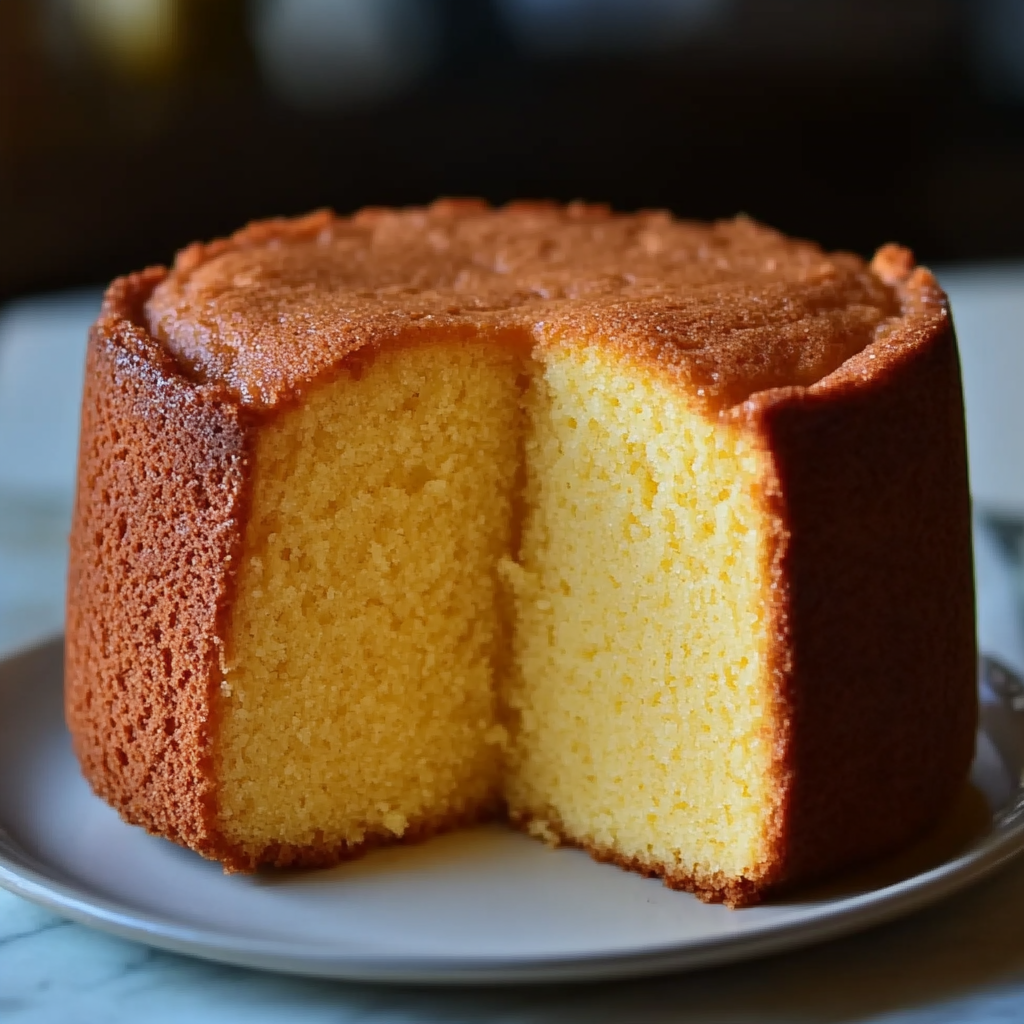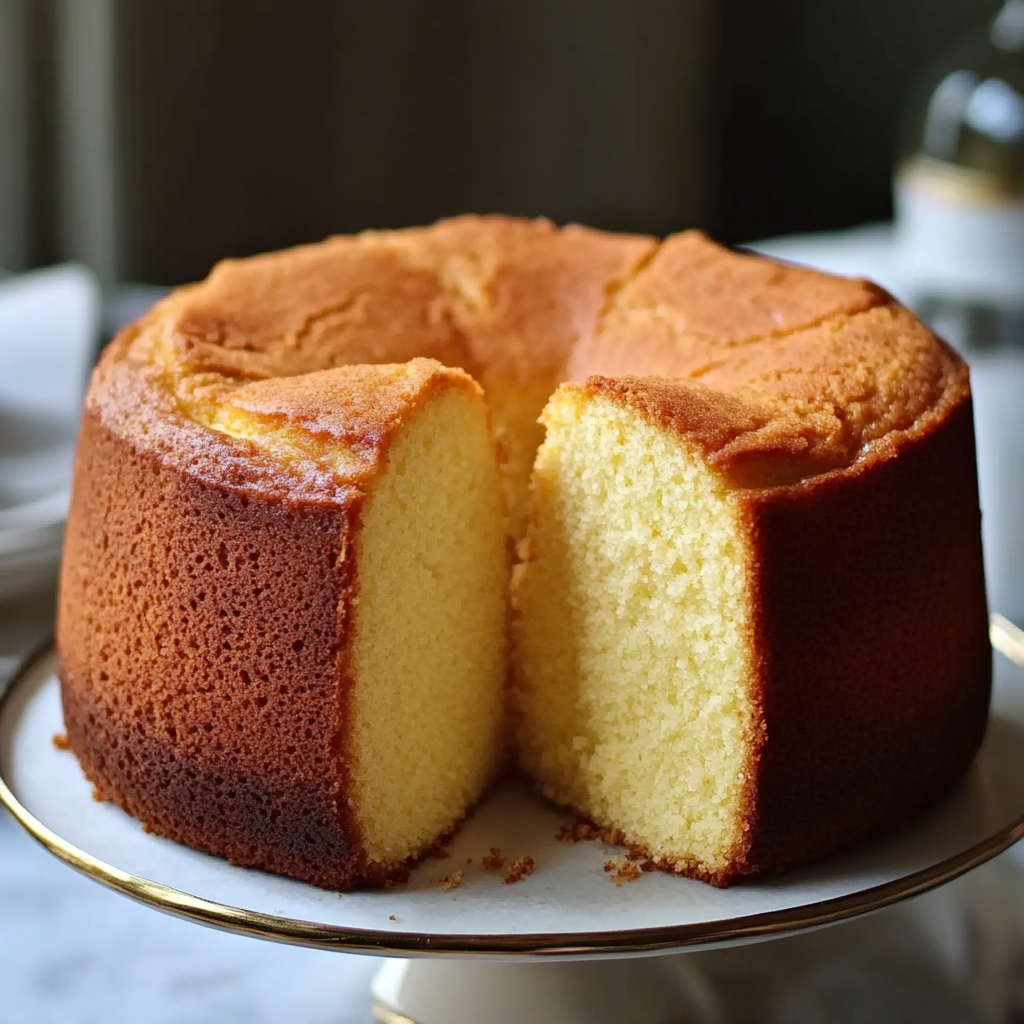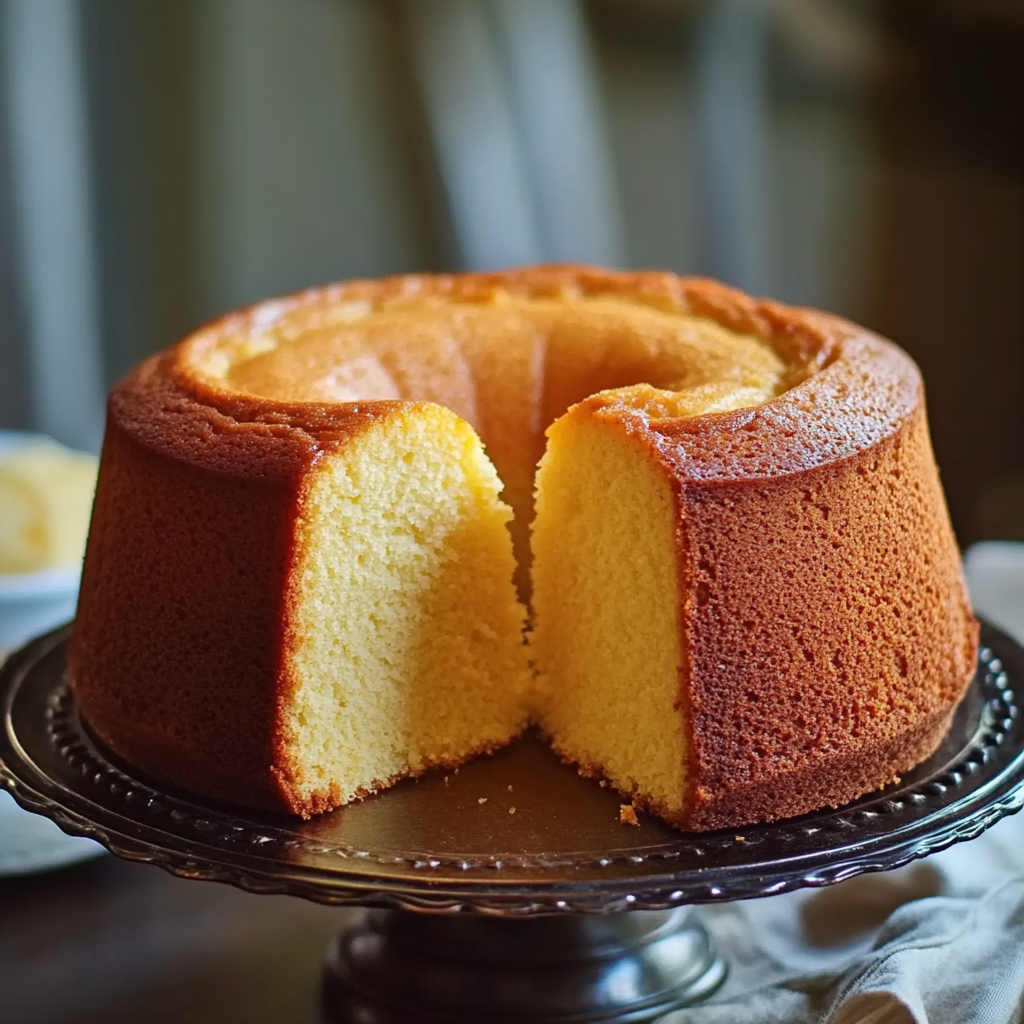Pound Cake
Few desserts are as classic, buttery, and comforting as a pound cake. Known for its dense yet tender crumb, this timeless treat has graced kitchen tables for generations. The name “pound cake” comes from its original formula — a pound each of flour, butter, eggs, and sugar. While modern recipes adjust these proportions for improved texture and taste, the essence remains the same: rich simplicity.
The roots of pound cake trace back to 18th-century Europe, where it was cherished for its straightforward ingredients and consistent results. Over time, it evolved across cultures — from the French “quatre-quarts” to the American South’s beloved cream cheese variations. Today, it holds a permanent place in every baker’s repertoire, valued not only for its nostalgic appeal but also its versatility.
What makes pound cake so beloved is its unique combination of density and moistness. Unlike airy sponge cakes or whipped chiffon cakes, pound cake’s hearty structure pairs beautifully with coffee, fresh fruit, or a simple glaze. According to the Wikipedia article on pound cake, its signature texture stems from the creaming method, a technique where softened butter and sugar are whipped together to incorporate air, giving the cake both lift and richness.
When baking pound cake at home, attention to detail is crucial. From choosing the right pan to using room-temperature ingredients, every step contributes to the final result. You’ll also want to understand the role of ingredients, such as how butter adds flavor and fat, while baking powder provides a subtle lift. These small decisions can mean the difference between a dry cake and the best pound cake you’ll ever bake.
If you’re looking for visual inspiration or presentation ideas, explore this Pinterest collection of classic pound cake ideas for tips on styling and serving. Whether you’re preparing it for a holiday, brunch, or simply a cozy evening at home, the best pound cake recipes start with understanding their foundation — a blend of precision, quality ingredients, and a bit of baking knowledge.
2. What You Need to Know Before Baking Pound Cake
Baking the perfect pound cake isn’t just about following a recipe — it’s about understanding the details that affect texture, flavor, and overall success. Whether you’re a beginner or a seasoned home baker, mastering a few essential techniques will elevate your results every time.
Essential Tools for Pound Cake Success
To get started, you’ll need a few basic tools that contribute to consistent baking:
-
Bundt or loaf pan: Choose a heavy, nonstick pan for even heat distribution.
-
Electric or stand mixer: Creaming butter and sugar properly requires sufficient power and time.
-
Measuring cups and kitchen scale: Accuracy matters — even a small deviation in flour or butter can change the outcome.
-
Cooling rack: Allows air to circulate around the cake and prevents sogginess.
The Role of Room-Temperature Ingredients
One of the most common mistakes in pound cake baking is using cold ingredients. When butter, eggs, and milk are at room temperature:
-
Butter creams smoothly with sugar, creating a lighter texture.
-
Eggs incorporate more evenly, improving structure.
-
Milk blends fully into the batter, preventing separation.
Room-temperature ingredients ensure a unified batter that bakes evenly and avoids dense or rubbery results.
Accuracy is Key: Why Measurements Matter
Precise measurement of ingredients is fundamental in baking science. Unlike cooking, where estimates often suffice, baking demands a more mathematical approach. Even slight alterations in flour or sugar can throw off the balance between moisture and structure. For example, excess flour can lead to a dry cake, while too much sugar may cause collapse.
You can learn more about the science behind these ingredients in the Wikipedia article on baking, which explains how the ratios of fat, flour, and liquid affect a cake’s outcome.
Avoiding Overmixing
While it’s tempting to beat until everything looks perfectly smooth, overmixing develops gluten — the protein in flour — which results in a tough, chewy texture. Mix only until the ingredients are just combined. This is especially important after adding the dry ingredients.
For more ideas on ingredient combinations and preparation methods, explore this Pinterest board featuring creative pound cake variations to see how bakers customize texture and flavor while respecting these foundational techniques.
With the right tools, room-temperature ingredients, and careful attention to mixing, you’re already on your way to creating the best pound cake recipe from your kitchen.
3. The Classic Pound Cake Recipe You’ll Ever Bake (Step-by-Step)
This is the ultimate pound cake recipe — moist, buttery, and incredibly easy to make at home. It sticks to classic foundations but incorporates modern techniques for maximum flavor and a perfect crumb. Follow each step precisely to achieve consistent results every time.
Ingredients You’ll Need
-
1 cup (2 sticks) unsalted butter, softened
-
2 cups granulated sugar
-
4 large eggs
-
1 tablespoon vanilla extract
-
3 cups all-purpose flour
-
½ teaspoon baking powder
-
½ teaspoon salt
-
1 cup whole milk
If you’re curious about how each of these ingredients affects your cake’s texture, check out this Wikipedia explanation on cake science — especially how flour and butter interact during baking.
Step-by-Step Instructions
-
Preheat your oven to 325°F (165°C). Grease and flour a 10-inch bundt or loaf pan.
-
Proper pan preparation prevents sticking and ensures even baking.
-
-
Cream the butter and sugar in a large mixing bowl. Beat on medium-high speed until the mixture is light, fluffy, and pale — about 4–5 minutes.
-
This step incorporates air, creating a lighter texture.
-
-
Add the eggs one at a time, mixing well after each addition.
-
Room-temperature eggs blend better and avoid curdling.
-
-
Stir in the vanilla extract for a rich, aromatic base flavor.
-
In a separate bowl, whisk together the flour, baking powder, and salt.
-
This evenly distributes the leavening agent and ensures even rise.
-
-
Gradually add the dry ingredients to the butter mixture, alternating with the milk.
-
Begin and end with the flour mixture. Mix on low speed just until combined.
-
-
Pour the batter into the prepared pan, smoothing the top with a spatula.
-
Bake for 60–70 minutes, or until a toothpick inserted in the center comes out clean.
-
Avoid opening the oven door early, as this can cause collapse.
-
-
Let the cake cool in the pan for 10 minutes, then transfer to a wire rack to cool completely.
-
This prevents soggy edges and allows the cake to set properly.
-
You’ll notice that this cake is dense, but moist, with a fine crumb and buttery finish — the hallmarks of a classic pound cake. For topping ideas, check out this Pinterest board of lemon glazes, which pairs beautifully with the subtle vanilla base of this cake.
Also, if you’re curious about experimenting further with baking powder or how it reacts in different batters, the Wikipedia article on baking powder gives a great overview of its function as a leavening agent.
This step-by-step method ensures a perfectly baked, golden-brown pound cake every time — ideal for birthdays, holidays, or a simple Sunday dessert.
4. Variations of the Classic Pound Cake
Once you’ve mastered the traditional recipe, exploring pound cake variations is a natural next step. Each version brings a unique flavor or texture twist, allowing you to adapt the base recipe for different occasions and personal preferences. Below are some of the most beloved and versatile adaptations.
Lemon Pound Cake
This bright, citrusy twist is one of the most popular variations. Add:
-
2 tablespoons of lemon zest
-
2 tablespoons of fresh lemon juice
-
A simple lemon glaze made with powdered sugar and lemon juice
The zest adds a fragrant, aromatic depth, while the juice introduces a mild tang that balances the buttery richness. For inspiration on presentation or glaze decoration, check this Pinterest board of lemon glaze ideas.
Cream Cheese Pound Cake
This version swaps out part of the butter for cream cheese, making the cake richer and denser.
-
Use 1 cup butter + 1 (8 oz) package of cream cheese
-
Cream together as you would butter
The cream cheese lends a slightly tangy flavor and a velvet-like crumb. It’s a Southern classic and pairs well with berry sauces or even chocolate drizzle.
Sour Cream Pound Cake
For extra moisture and a slight tang, substitute 1 cup of sour cream for the whole milk. This version is excellent for those who want a soft crumb and long shelf life.
-
Use full-fat sour cream
-
Add ½ teaspoon of almond extract for a deeper flavor
Buttermilk Pound Cake
Swap milk for buttermilk to add tenderness and complexity. Buttermilk reacts with baking powder for a slightly airy texture.
-
Use 1 cup buttermilk
-
Consider adding orange zest or a hint of cinnamon for a warm flavor profile
You can learn more about how ingredients like buttermilk affect the cake structure by reading up on baking techniques, particularly those related to acidic ingredients.
Chocolate Swirl or Marble Pound Cake
This eye-catching version includes a cocoa swirl in the vanilla batter.
-
Reserve 1 cup of the finished batter
-
Mix in ¼ cup unsweetened cocoa powder
-
Layer the chocolate batter in between vanilla layers and swirl with a knife
This variation adds visual appeal and balances bitterness and sweetness, making it ideal for dessert spreads or potlucks.
For more creative inspiration, explore this Pinterest collection of creative pound cake variations, which includes mix-ins like blueberries, matcha, or even Nutella.
Every variation starts with a solid understanding of the classic technique, then introduces flavors that suit your style. Whether you’re keeping it traditional or making it festive, these pound cake recipes are endlessly customizable and always crowd

5. How to Store and Freeze Pound Cake
Proper storage is essential to maintain the freshness, moisture, and texture of your pound cake. Whether you plan to eat it over a few days or save it for later, these methods will help preserve its rich, buttery flavor.
Storing at Room Temperature
If you plan to consume the cake within 3–4 days, room temperature storage is ideal.
-
Let the cake cool completely before storing.
-
Wrap it tightly in plastic wrap or aluminum foil to prevent it from drying out.
-
Place it in an airtight container to protect it from air exposure and retain its moisture.
Avoid refrigerating pound cake unless necessary. The refrigerator can dry it out and alter its texture.
Freezing Pound Cake
Freezing is a great option if you want to extend the cake’s shelf life without compromising quality. A properly frozen pound cake can last up to 3 months.
To freeze the entire cake:
-
Wrap it tightly in plastic wrap, then again in aluminum foil.
-
Place it in a heavy-duty freezer bag or airtight container.
To freeze individual slices:
-
Slice the cake once it has completely cooled.
-
Wrap each slice individually in plastic wrap and foil.
-
Store the wrapped slices in a labeled freezer-safe container.
When ready to serve, remove the desired portion from the freezer and let it thaw at room temperature. You can also warm slices slightly in the microwave for a freshly baked feel.
For more expert tips on cake storage and freezing techniques, see the Wikipedia article on cake, which covers preservation methods based on cake types and ingredients.
If you’re looking for visually appealing ways to serve leftover or frozen pound cake, this Pinterest board on pound cake serving ideas offers elegant options for repurposing slices with fruit, sauces, or even grilling.
Knowing how to store and freeze pound cake properly not only saves time but also ensures that every bite tastes just as good as when it first came out of the oven.
6. How to Serve Pound Cake
Pound cake is incredibly versatile when it comes to serving. Its dense, moist texture makes it a perfect canvas for both simple and elaborate presentations. Whether you’re enjoying it casually or elevating it for an event, there are countless ways to make it shine.
Classic Serving Ideas
-
Plain: Serve thick slices on their own to let the buttery richness speak for itself.
-
With fresh fruit: Strawberries, blueberries, and peaches add a fresh, juicy contrast.
-
Topped with whipped cream: A dollop of light whipped cream balances the cake’s density.
For those who enjoy pairing desserts with tea or coffee, pound cake makes an ideal match thanks to its subtle sweetness and rich mouthfeel. You can find creative visuals and pairings in this Pinterest collection of serving ideas.
Dressed-Up Options
-
Drizzled with glaze: A vanilla, lemon, or chocolate glaze adds sweetness and shine.
-
Grilled slices: Lightly grill for a caramelized surface and serve with ice cream.
-
Layered in trifles: Cubed pound cake makes an excellent base for layered desserts with cream and fruit.
No matter the presentation, the key is balance: complement the cake’s rich texture without overwhelming it.
7. Common Mistakes to Avoid When Making Pound Cake
Even experienced bakers can run into issues with pound cake. Understanding what to avoid will help ensure consistent results every time.
1. Overmixing the Batter
-
Overmixing develops gluten, leading to a dense or rubbery cake.
-
Mix only until the ingredients are combined, especially after adding the flour.
2. Using Cold Ingredients
-
Cold butter doesn’t cream properly, and cold eggs don’t mix evenly.
-
Always use room-temperature ingredients for a uniform batter and smooth texture.
3. Incorrect Oven Temperature
-
Baking at too high a temperature can cause the cake to rise too quickly and collapse.
-
Always bake at 325°F and use an oven thermometer if necessary to verify accuracy.
The importance of temperature control is also highlighted in the Wikipedia article on baking, which explains how heat influences leavening and structure.
4. Under-Greasing the Pan
-
Always grease and flour the pan thoroughly to avoid sticking.
-
Use a baking spray with flour or butter and dust with flour for best results.
5. Removing the Cake Too Soon
-
Allow it to cool in the pan for at least 10 minutes before transferring to a wire rack.
-
Removing it too early can cause it to break or collapse.
Avoiding these common mistakes will help ensure your pound cake turns out moist, golden, and flavorful — every single time.
8. Pound Cake vs. Other Cakes: What Makes It Unique?
Understanding how pound cake differs from other types of cakes helps highlight why it’s such a timeless favorite.
Texture and Density
-
Pound cake is denser than sponge cakes, which use whipped eggs for a light texture.
-
It’s heavier and more substantial, making it ideal for slicing and storing.
Fat Content
-
Pound cake contains more butter and fat than chiffon or angel food cakes.
-
This contributes to its moistness and rich mouthfeel.
For more on how butter affects cake structure and taste, refer to this Wikipedia page on butter, which dives into its baking properties.
Flavor Profile
-
Typically flavored with vanilla, citrus zest, or almond extract.
-
Unlike frosted cakes, pound cake often stands alone or with simple glazes.
These characteristics make pound cake a distinct category of dessert — one that’s easy to customize, rich in flavor, and perfect for nearly any occasion.

9. FAQs
What makes pound cake dense?
A dense pound cake can result from too much flour or overmixing the batter. Using room-temperature ingredients and following the proper mixing technique prevents a heavy texture.
Can I use self-rising flour instead of all-purpose?
It’s not recommended, as self-rising flour contains added leavening agents and salt, which may interfere with the balance of the recipe. Stick with all-purpose flour and manually add baking powder and salt for control.
Why did my pound cake fall in the middle?
This often happens when the oven temperature is too high or the cake is underbaked. Be sure to bake at 325°F and test with a toothpick before removing.
How can I make my pound cake more moist?
To increase moisture:
-
Use sour cream, cream cheese, or buttermilk.
-
Avoid overbaking.
-
Make sure ingredients are measured accurately.
For ideas on variations that enhance moisture, check this Pinterest board of holiday pound cakes featuring seasonal ingredients and glazes.
Can I bake pound cake in a regular cake pan?
Yes, but the baking time may vary. Loaf and bundt pans are ideal, but round pans work if you’re cautious with timing and doneness checks.
What’s the best glaze or topping for pound cake?
Simple vanilla or lemon glazes are classic choices. You can also top with fresh berries, fruit compote, or even a drizzle of melted chocolate. Explore this Pinterest board of classic pound cake inspiration for ideas.
PrintThe Best Pound Cake Recipes You Can Make at Home
This classic pound cake recipe is rich, moist, and irresistibly buttery. It’s made with pantry staples — butter, sugar, eggs, flour, and milk — and enhanced with vanilla extract for a warm, inviting aroma. Baked to golden perfection in a loaf or bundt pan, it offers a dense yet tender crumb, perfect on its own or dressed up with fruits and glazes.
Whether you’re a first-time baker or a seasoned pro, this reliable recipe delivers a flawless pound cake that’s ideal for any occasion — from family brunches to festive gatherings.
- Author: Clara
Ingredients
- 1 cup (2 sticks) unsalted butter, softened
- 2 cups granulated sugar
- 4 large eggs
- 1 tbsp vanilla extract
- 3 cups all-purpose flour
- ½ tsp baking powder
- ½ tsp salt
- 1 cup whole milk
Instructions
Preheat your oven to 325°F (165°C). Grease and flour a 10-inch bundt or loaf pan.
In a large mixing bowl, cream the butter and sugar together until light and fluffy.
Add the eggs one at a time, mixing well after each addition. Stir in the vanilla extract.
In a separate bowl, whisk together the flour, baking powder, and salt.
Gradually add the dry ingredients to the butter mixture, alternating with the milk, beginning and ending with the flour mixture. Mix until just combined.
Pour the batter into the prepared pan and smooth the top.
Bake for 60–70 minutes, or until a toothpick inserted in the center comes out clean.
Let the cake cool in the pan for 10 minutes, then transfer to a wire rack to cool completely.
Notes
-
Butter must be fully softened to ensure proper creaming with sugar.
-
Use large eggs at room temperature for best emulsion and texture.
-
Alternate dry and wet ingredients to prevent curdling and maintain structure.
-
Do not overmix once the flour is added to avoid tough texture.
-
Cool completely before slicing to preserve the cake’s structure.





